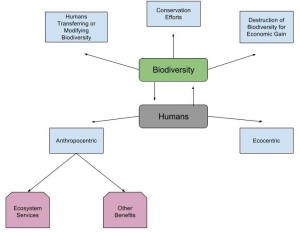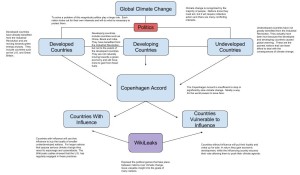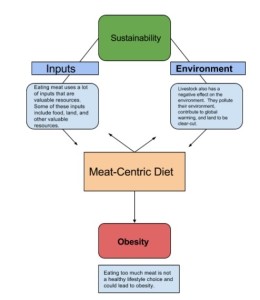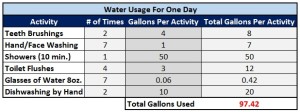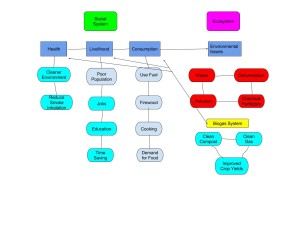Part One: Draw on the lecture to create a system diagram that shows how humans impact biodiversity and vice versa.
Part Two: In 250-300 words explain your system diagram.
This diagram shows how biodiversity and humans are interrelated. Each affects the other in various ways that I tried to capture. I also attempted to show that there are different lenses though which one can examine the interaction. To start I have an arrow pointing from biodiversity to humans. This signifies that biodiversity impacts humans and the arrow in the opposite indicates the same, only for humans. Biodiversity impacts humans first through an anthropocentric view. This is further broken down into ecosystem services, which include all of the quality of life benefits we receive such as clean air, water, replenishing soil and maintaining a proper heat balance in the atmosphere. The other uses are more economic and provide a more tangible benefit. For example biodiversity provides us with medicines, food, recreation and scientific information. On the other branch we have the ecocentric branch. Humans don’t really receive anything in this view, but we understand that biodiversity has an intrinsic value and a right to exist. In the other direction, from humans to biodiversity, I have three main categories. The first category signifies that humans have impacted biodiversity through movement and migration. Also, that we have affected it through selective breeding in agriculture. Conservation efforts can stem from both ecocentric and anthropocentric views, but the point is that humans realize the need for biodiversity and affect it through conservation. Lastly, I have destruction of biodiversity for economic gain. I think this is the largest impact that humans have had on biodiversity. Throughout time we have chosen our needs over the needs of the environment, which has harmed biodiversity. This trend continues to this day and is a complicated issue to solve.
Part Three: In 325-350 compare and contrast the deforestation in the U.S. and the deforestation in the Amazon. Examine the reasons for the deforestation and consider the ethical implications. What should be done?
There are many reason for the deforestation in the Amazonian forest. For starters the government incentivizes this deforestation through a combination of tax breaks and subsidies. The Amazon also suffers because of clear-cutting for cattle, subsistence farming, commercial agriculture and logging (Lind). The commonality between all of these activities is that they benefit people by providing economic opportunities. This poses an ethical question and a choice between people or the environment. The same situation took place in the U.S. as we learned within the lecture. The U.S. chose people over the environment as nearly all of our virgin forests have been clear-cut. Many of the governmental policies between Brazil and the U.S. are also very similar. For example the U.S. provides subsidies to farmers and the agriculture industry enjoys substantial property tax breaks. We also destroyed our forests for economic gain through logging, agriculture, and other activities that contributed to economic development. The essential question is how can we as a nation ask other countries to protect their biodiversity when we destroyed ours? The U.S. gained so much in economic terms through the exploitation of our natural resources. It’s unjust of us to expect people of other nations to forgo economic development in favor of biodiversity. This is similar to the conflict we examined within the climate change module. In the climate change module the developed nations benefited from exploiting fossil fuels, while less-developed nations are just beginning to reap the benefits. Once again it’s unfair of us to expect them to give up their economic development. I think the only course of action is for developed nations to contribute to a worldwide fund. This fund would be used to fund sustainable investments in nations where biodiversity is threatened. The purpose of the fund would be to provide economic opportunity to locals, while protecting the forests. Providing an alternative source of income is one of the best ways to discourage deforestation, while also benefiting the local population.
Lind, Derick. “Impacts and Causes of Deforestation in the Amazon Basin.” Impacts and Causes of Deforestation in the Amazon Basin. Kanat, 6 May 2010. Web. 21 Apr. 2016.

